MARKETING
Give Your Marketing A Makeover

For small and boutique salon owners, regular clients are often the heart of the business. From driving sales to influencing by word of mouth, customers are critical for any beauty business.
However, growth is both important and inevitable for a new beauty business. The goal soon becomes maintaining your regular customers while constantly growing the brand.
So, how is a salon owner supposed to make it work?
Turn to salon marketing!
Ensuring outreach and retention happens through targeted marketing and market-focused thinking. Finding the best way to extend that focus is often a major hurdle for business owners. Fortunately, salon owners have plenty of tricks at their disposal.
Here are four of the most impactful marketing techniques for beauty business owners.
Social Media is Key
In today’s hyper-connected world, a business without a strong social media presence is missing out on growth. Most customers use several forms of social media throughout their day.
For success, make your presence known across those social media channels.

Your business must have a Facebook page. It creates a centralized hub of connectivity for your customers. Plus, Facebook Ads help put the salon’s name directly in front of new customers.
Be sure to target your specific audience. Younger customers are more likely to use Instagram and TikTok rather than Facebook. Consider going the extra step and collaborating with local influencers. Doing so allows:
- A known name to represent your brand and products.
- The salon to connect with hundreds of potential customers.
- The public to see the skills of the stylists.
- An “inside look” into the business, which boosts connections with new and existing customers.
If social media isn’t a forte within the salon, consider hiring a social media manager.
Specialized channels like Instagram and TikTok benefit from a dedicated manager. They film and edit videos and pictures, and they interact with your customers online.
Think of a social media manager as the public mouthpiece of the salon. Their expertise and marketing knowledge helps ensure the salon has an impactful online presence.
Focus on Your Customers
Salon marketing is all about showing the business to more and more people. However, that doesn’t mean advertising without a strategy.

Today’s customers are savvy when it comes to marketing. Daily email notices or stale Facebook ads are now a detriment, not a marketing tool.
Today’s consumers want personalized, relevant communication. After all, nearly 80% of customers desire personally-appropriate marketing from a business.
Some key ways to keep the salon customer-centered include:
- Send emails or texts after appointments asking for reviews and feedback. This provides an endless list of what your customers expect.
- Use birthdays and sign-up days for specialized discounts. This is a perfect way to deliver personalized marketing.
- Delete your generic email blasts. Instead, ensure the emails contain quality, pertinent information that your customers want.
For your in-store customers, gently encourage them to sign up for email and text alerts. It allows your customers to have to-the-minute information, in addition to advanced knowledge on specials, pricing, and even appointment reminders.
Loyalty Programs Build Retention
Social media marketing ensures the salon reaches the masses. Your stylists keep your customers happy through their expertise.
So, how do you get them to stay happy and continue generating positive word-of-mouth marketing?
Provide them with a loyalty program.
Nearly 85% of all customers choose businesses that offer loyalty programs, and a majority feel that those programs are beneficial.

Are You Ready to Master Social Media?
Become a Certified Social Media Specialist and learn the newest strategies (by social platform) to draw organic traffic to your social media sites.
Points-based programs or accumulated tier models encourage customers to continue visiting. Meanwhile, referral programs help grow your customer base. And since these referrals come from trusted sources, those referred are more likely to remain customers.
The sky’s the limit when it comes to loyalty programs. For example, reward people for their repeat business by providing a free 10th service.
Or, encourage new product discovery through discounts at checkout. Checkout purchasing is already incentivized. Thus, with discounts applied, the customer is more likely to purchase.
As well, don’t feel locked to one style of loyalty program. A referral system and a points system are perfect in the same store.
Consider, too, combining services for different tiers of customers. This creates an even more personalized program with a higher emphasis on loyalty.
Focus on Local Communication and Outreach
A great way to advertise a salon is to simply “be there” when relevant. Specifically, work to tie the salon to local beauty events.
A prime place to start is to host open house events. For instance:
- Provide meet-and-greets with stylists for increased customer connection.
- Host product demonstrations (and give those attending discounts or free items).
- Hold charitable events at the salon, such as hair donations or toiletry donations for women’s shelters.
Charity, in particular, is a solid way to build connections with the community. Match donated items or amounts. Sponsor local events, like charity races or community festivals.
As a sponsor for community events, the salon is always at the forefront of the public’s mind.

Sponsorship also creates new leads and partnership opportunities, not to mention boosting your salon throughout all available channels at the same time.
Becoming a known name within the community is an excellent way to connect with customers. Highlight the salon’s goodwill through charity and community outreach. Customers love a business that proves it cares about them.
Final Thoughts
Marketing for your salon is all about connecting with the customer. From a strong social media presence to a meaningful loyalty program, customers want the experience to be about them. The best way to achieve that is to cater your marketing to the individual.
Use personalized emails to deliver birthday discounts. Or, focus on customer history to provide specialized sales.
Sponsor community events to highlight the expertise of your stylists. And always ask for feedback from your customers. Understanding what the customer wants is best heard directly from the source.
MARKETING
3 Contextual Link-Building Strategies That Actually Work

Quality content can get your web pages ranking higher in Google search results. But contextual links can help, too.
Google says the inclusion of relevant, high-quality links signals the content that includes them may be quality content, too.
So, how can you earn contextual links to give your content an edge over the competition? Adopt one, two, or all three of the strategies detailed in this article.
But first, let’s understand what contextual links are.
What are contextual links?
A contextual link appears in the body of a web page’s content. A hyperlink is added to a relevant word or phrase. They:
- Link to other pages on the site.
- Cite the source of a claim or statistic.
- Indicate other relevant pages.
- Provide readers with more in-depth information on the topic.
- Guide readers to a product or service.
In this screenshot of an article with the header, Challenges of Productivity Tracking in Remote Workplaces, three phrases are hyperlinked — measure productivity, Microsoft, and research by Gartner.
Each contextual link serves a purpose:
- “Measure productivity” goes to a Slack article about how to measure employee productivity.
- “Microsoft” directs the reader to the original research for the cited statistic.
- “Research by Gartner” links to the native source for the research cited in that paragraph.
With a contextual link-building strategy, you not only boost your content in the eyes of Google but also encourage other sites to use your valuable content to provide their readers with additional information or context.
Now, let me show you three strategies to grow your contextual links and improve your content’s rankings.
1. Help sites fix their broken links
Broken link building involves contacting a website, pointing out a broken external link on a page, and suggesting your content as its replacement.
Broken links could result from a 404 error, a blank page, or a redirect to an irrelevant page — any alteration that ruins the original link’s purpose.
Since broken links negatively affect the visitor experience, removing them is in the site’s best interest. Your replacement offer gives them a quick solution to their problem. Plus, people are more willing to help you after you’ve helped them.
To find broken links, use a tool like Free Backlink Checker extension. I also like to inspect links manually since most tools only pick up 404 errors. Rely solely on them, and you will miss relevant broken-link opportunities.
Ahrefs also has tools for finding broken links. Its free broken link checker is helpful, but the paid version is more robust.
Paid subscribers can go to Site Explorer, go to the Outgoing Links report, and click on “Broken Links” from the dropdown menu.
The report identifies the total number of broken links (3,136 in the example below), the referring pages (the URL for the content including the broken link), the anchor (the words hyperlinked in the content), and the link (the URL that no longer directs to a viable page).

Ahrefs subscribers can also compile a Best by Links report under the Pages option in the Site Explorer tool.
In this example, the report lists pages with 404 page-not-found errors for TheMuse.com. It has 6,230 pages with broken external links. Each page URL listed is accompanied by the number of referring domains and a number of links to the page.
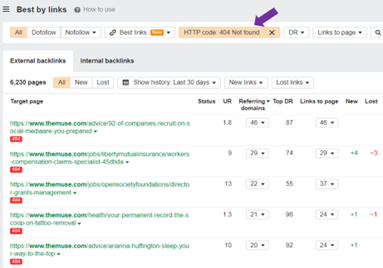
This research can identify the topics with the biggest potential to become the fixes for a broken link. You can create content to address them or identify content you already published. Just make sure the content closely matches the intent of the anchor text’s original link.
For example, the same research report, which is now a broken link, is cited in articles from Oyster and TINYpulse. On Oyster, the anchor text reads, “44% of companies did not allow remote work.” On TINYpulse, the anchor text says, “only 33% are very satisfied with the level of trust in their organization.”
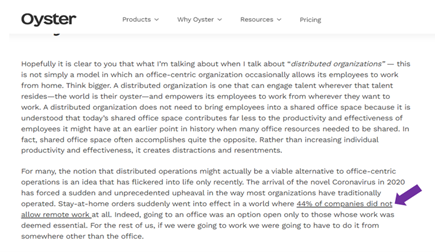
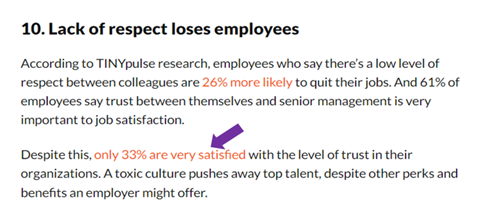
For a single article link to replace the broken link on Oyster and TINYpulse, the content would need to cite both a statistic about remote work and another stat about trust in organizations.
2. Guest posting
Like the broken-link replacement strategy, guest posting benefits both your and the recipient’s sites. You reach out to sites and offer to write content about a topic relevant to their audience that relates to your content subjects and includes a link to your site. This technique works well because you typically control where and how to add your link to make it as relevant as possible.
You can take multiple approaches to win guest-posting opportunities. No matter which tactics you use, track the sites and verify the site’s quality using Ahrefs, another tool, or a direct visit to the site.
First, you can use Ahrefs (or a similar tool) to examine your competitors’ backlinks and identify any links that come from guest posts. The anchor or surrounding text might hint at its status with phrases such as “contributed by,” “guest post by,” or the name of the brand or author. You also can check links manually to see if they’re contributed content.
In this example from Collegiate Parent, the headline reads “EFC Too High? Tips for Successful Aid Appeals” and includes a byline for “Billie Jo Weis.” At this point, you don’t know if it is a contributed article.

But scroll down to the end, and you can see the author’s bio. It confirms the article is a guest post because her bio says she is a client services advisor for My College Planning Team, not the publisher (Collegiate Parent).
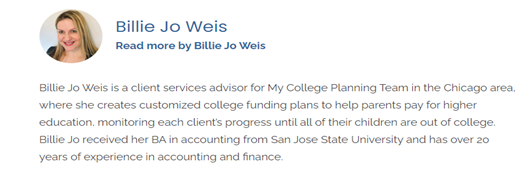
You can also use Google search operators to identify sites open to guest contributions. You’ll want to do several searches using variations of your target keywords and topic accompanied by phrases, such as “guest post,” “contributed by,” “guest post by,” and “guest posting guidelines.”
The example in the screenshot below works for a brand targeting college prep topics. The search is “’college prep’ ‘guest post by’ -site.pinterest.com.” The results reveal four articles from four sites that use the words “college prep” and “guest post by.” You can add those sites to your outreach tracker.

Finally, you can list sites relevant to your niche that didn’t appear in the earlier searches.
TIP: Not all sites that accept guest articles say so on their website.
3. Niche edits
A niche edit, sometimes referred to as a link insert, is a technique that adds a link to existing content. The key to success is finding relevant articles on high-quality sites and pitching your content as a valuable addition to those articles.
You can use a similar process to the Google guest post search. Input a broad keyword for your targeted keyword, then tell it you don’t want the targeted keyword in the title. If the entire article is about your targeted keyword, your chances of getting the publisher to include a link to a similar article are low.
Here’s an example from one of our client’s that sought to make niche edits for the keyword “soft skills.”
The Google search included these phrases:
- “Organizational development” soft skills -intitle:”soft skills”
- “Organizational development” soft skills employee training -intitle:”soft skills”
- Soft skills employee training -intitle:”soft skills” organizations
It led to an added link for “soft skills” in this article — “Employee Development,” which includes the header, “What are the benefits of employee development for an organization?”
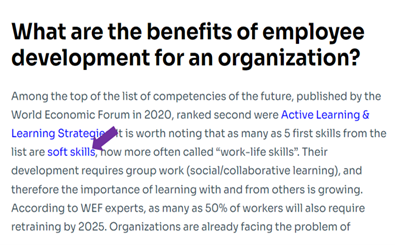
You can do several searches, modifying your search operators each time to see what sites and content appears. Think of multiple angles to broaden the potential sites that publish content with your targeted or a related keyword.
After you’ve crafted a list of high-quality prospects, it’s time for outreach.
Niche edits might be the hardest of the three strategies to achieve because they’re not as clear of a win-win situation as the other two (repairing broken links and publishing new content).
Your email pitch can make or break your niche-edit campaign. It must convince the publisher that your content provides so much value that they will want to take an extra step with content they’ve already completed.
Here are some tips to craft a link-earning email pitch:
- Start by mentioning something about them. It could be something you like about their website or the article you’re targeting. You want them to know you’ve explored their site and read the article. But don’t overdo it. A simple compliment or sentence about how you found the article helpful should suffice.
- Introduce your content and mention how it can help their audience. Be concise and convincing, but don’t oversell it.
- Go one step further and point to a section or sentence where you think your content might be a good fit. This will help them see where your content can add value and link to it.
Get linking
Though contextual link building may seem challenging to execute, it can bring great rewards. Follow these tips and strategies, and your valuable content will get more attention from external sites and eventually Google rankings where it deserves to be.
All tools mentioned in this article are identified by the author. If you have a tool to suggest, please tag CMI on social.
HANDPICKED RELATED CONTENT:
Cover image by Joseph Kalinowski/Content Marketing Institute
MARKETING
Google’s Surgical Strike on Reputation Abuse

These aren’t easy questions. On the one hand, many of these sites do clearly fit Google’s warning and were using their authority and reputation to rank content that is low-relevance to the main site and its visitors. With any punitive action, though, the problem is that the sites ranking below the penalized sites may not be of any higher quality. Is USA Today’s coupon section less useful than the dedicated coupon sites that will take its place from the perspective of searchers? Probably not, especially since the data comes from similar sources.
There is a legitimate question of trust here — searchers are more likely to trust this content if it’s attached to a major brand. If a site is hosting third-party content, such as a coupon marketplace, then they’re essentially lending their brand and credibility to content that they haven’t vetted. This could be seen as an abuse of trust.
In Google’s eyes, I suspect the problem is that this tactic has just spread too far, and they couldn’t continue to ignore it. Unfortunately for the sites that were hit, the penalties were severe and wiped out impacted content. Regardless of how we feel about the outcome, this was not an empty threat, and SEOs need to take Google’s new guidelines seriously.
MARKETING
18 Events and Conferences for Black Entrepreneurs in 2024

Welcome to Breaking the Blueprint — a blog series that dives into the unique business challenges and opportunities of underrepresented business owners and entrepreneurs. Learn how they’ve grown or scaled their businesses, explored entrepreneurial ventures within their companies, or created side hustles, and how their stories can inspire and inform your own success.
It can feel isolating if you’re the only one in the room who looks like you.
-

 SEO7 days ago
SEO7 days agoHow to Use Keywords for SEO: The Complete Beginner’s Guide
-

 MARKETING2 days ago
MARKETING2 days ago18 Events and Conferences for Black Entrepreneurs in 2024
-

 MARKETING5 days ago
MARKETING5 days agoAdvertising on Hulu: Ad Formats, Examples & Tips
-

 WORDPRESS5 days ago
WORDPRESS5 days agoBest WordPress Plugins of All Time: Updated List for 2024
-

 MARKETING6 days ago
MARKETING6 days agoUpdates to data build service for better developer experiences
-

 MARKETING7 days ago
MARKETING7 days agoThe Ultimate Guide to Email Marketing
-

 WORDPRESS6 days ago
WORDPRESS6 days agoShopify Could Be Undervalued Based On A Long-Term Horizon
-

 PPC6 days ago
PPC6 days agoLow Risk, High Reward YouTube Ads alexking
















